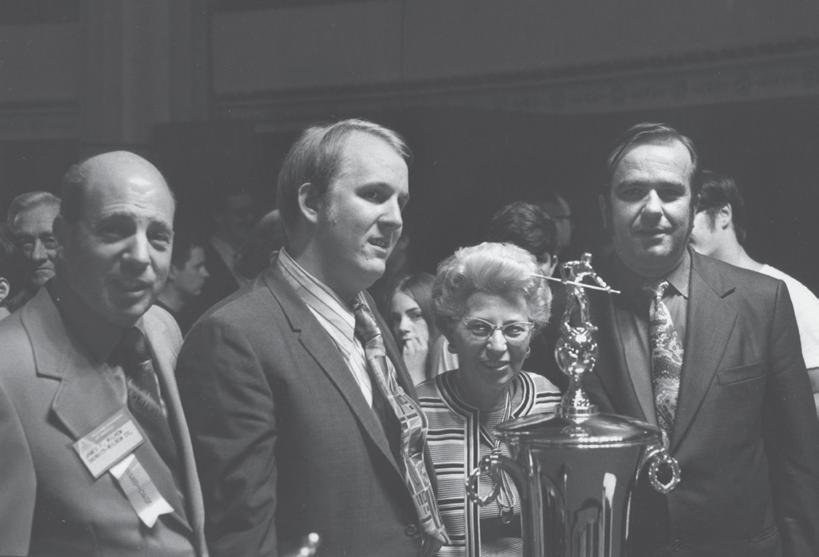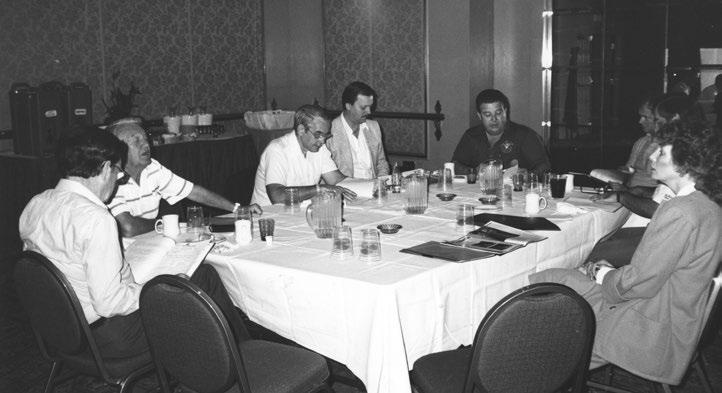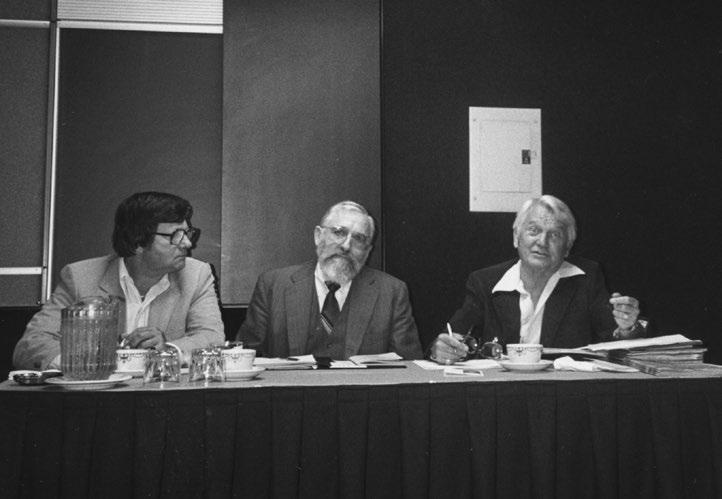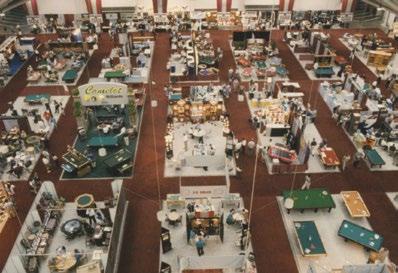
6 minute read
THROUGH YEARS
When the Billiard Congress of America (BCA) was established in 1948, its original objective was to organize pool players and promote the sport through qualifying tournaments at the local, regional and national levels for both straight pool and 3-cushion billiards.
At the start, famous players like Willie Mosconi and Willie Hoppe were involved and helped to bring prestige to the association.

Other important efforts at the beginning included creating an official rulebook to standardize billiards and help fund the effort, involving billiard rooms, retailers and manufacturers in meeting these promotional goals.
Here is a look at some of the Billiard Congress of America’s biggest accomplishments over the last 75 years, broken up into 25-year periods.
THE FIRST 25 YEARS 1948-1973
Michael I. Shamos, noted billiard historian who wrote The Illustrated Encyclopedia of Billiards, was asked to pen a history of the Billiard Congress of America at its 50th anniversary, and remembers fondly putting that together and reliving the exceptional work that the association had done up until that time – and continues to do today.
“It was called, ‘Setting the Stage for 50 Years’ and was 119 pages long and covered all the reigns of the BCA presidents and what happened during their tenures,” Shamos says. “But it ends in 1998 because that’s when it was published.”
Shamos was first exposed to the Billiard Congress of America when he used to see the rule book for sale at his college bookstore and he would buy a copy every year. He’s been on the BCA Hall of Fame committee since 1990, was on the rules committee for a brief time, and knows the association is very important for the survival of the sport.



He noted every sport needs a governing body to set rules and establish records and the BCA has done some wonderful things over its entire 75 years.
During WWII, only one world pool tournament was held, a 1942 championship won by Willie Mosconi. So, one of the first orders of business for the newly formed BCA in 1948 was to reestablish the world event, which it supported for another 20 years.

“It’s very important in every sport to have a world champion, as that’s what makes newspapers and reminds the world the sport exists,” Shamos says. “You need that signature tournament. Where would golf be without the Masters or football without the Super Bowl? Nowhere.”
Thanks to BCA’s sponsorship, legions of fans got to know the great players through their highly-publicized tournament performances and quest for high-run records. Without this exposure, sponsored by the BCA, the game wouldn’t have its legends.
Another early endeavor by the BCA was supporting the ACUI and the Boys’ Clubs, promoting intercollegiate competition. This kept the game of pool alive for those who went to college, when historically, many people quit the game during this time in their lives.
One of the BCA’s first directors was Walter Hall, who headed national programs for the Boys’ Clubs. He saw the opportunity to introduce pool to young people in a clean environment that would not frighten their parents. The follow-up was that when the kids got to college, they could continue competing in intercollegiate tournaments.
“At times, there wasn’t enough money to pay travel costs for the players, so they couldn’t actually face one another on the same table and the runs had to be transmitted between the schools by telephone,” Shamos says. “It seems like such a silly way to hold a competition, but it kept people playing, and it was especially good at getting them at an age when they could start a long-term love affair with the game.”
The BCA Official Records and Rule Book was first published in 1948 and remains the billiard bible for players, historians and anyone involved in the game. The Rule Book gives players something to strive for as they read the achievements of past champions and marvel at the BCA Hall of Famers.
The Rule Book’s biggest accomplishment, however, has been systematizing the rules. Unless a game has stable rules and equipment specifications, there’s no way to compare players or have a fair contest. The BCA rules are the basis for the World-Standardized Rules, establishing a framework for pocket games all over the globe.
In 1966, the BCA started the U.S. Open for men, with a women’s division set up the following year. This quickly became the premier tournament in the United States. Why was Steve Mizerak famous before the Miller Lite commercial? He kept winning U.S. Opens.
Before the BCA U.S. Open, there had never been an open national or world title pool tournament in U.S. history. Every title event prior to that had been exclusively invitational, as far back as 1863. Some, particularly during the 1930s, invited so-called “sectional” champions from different regions of the country to play in the world championship, but entries in the sectionals were carefully controlled to keep out “undesirables.” This made the top echelon of pool an exclusive male club. Between 1916 and 1956 only eight different people held the title even though it was contested on 73 occasions during those 40 years.
“You might think it strange that with so many good players –especially in New York and Philadelphia alone – no one else ever made it to the top,” Shamos says. “The BCA thought so too and realized that more public participation was needed. I’m confident that women’s pool would not be what it is now without the U.S. Open and the role models it produced.
To commemorate the great players and industry professionals who have enriched the sport and industry, in 1966, the Billiard Congress of America created the BCA Hall of Fame.

The Greatest Player category is reserved for outstanding players who have been active in national or international competition for at least 20 years and have won at least one national or international championship, while the Meritorious Service category is reserved for those who have made lasting, memorable and important contributions to billiards.
“Once you have a Hall of Fame, you have heroes who are role models and people aspire to be like them,” Shamos says. “The ones who break the records, who dominate, who crush, who inspire awe. Its occupants dwell in the platonic heights of billiard heaven: Hoppe, Mosconi, de Oro, Schaefer and Greenleaf, to say nothing of the living members. It sets up a standard of excellence to which mere mortal players aspire, and providing that goal, that path, is what keeps many good players striving for greatness and many great players pushing the envelope.”

THE SECOND 25 YEARS (1974-1998)
In 1977, the BCA launched the North American 8-Ball Championships, filling a hole that was much needed in the billiard world.
“For 100 years, 8-ball had been the most popular pool game but there was never competition in it; it was the forgotten game in tournament play,” Shamos says. “People like to see a game they’re familiar with. The BCA realized this when it set up the North American Championships, and dangling a title out there is a good way to keep a game flourishing.”
In 1982, the BCA’s Board of Directors created an industry trade show, at which all segments of the sport could meet. Today the BCA Expo is the industry’s largest annual billiard and home leisure show. In addition to exhibits, the event features business seminars for all sections of the billiard industry and social events designed to promote peer to peer relationships.



“When the BCA held its first trade Expo, it gave those in the industry the information they needed in terms of products and services and it kept its members prominently in world view,” Shamos says. “As time for the Expo approaches, the excitement level in billiards rises. Everyone counts on seeing each other at the show to do business or just renew acquaintances.”
Another important step in the ’80s was joining the World Pool-Billiard Association and realizing that pool couldn’t truly have a world champion if only American players were involved. After all, the World Pocket Billiard Championship (1901-1990) and the World Three-Cushion Championship (1914-1953) took place in the U.S., every year with the exception of a 1908 carom event in Havana, Cuba.
During the 1980s, when interest in the game ebbed here, more European and Asian players came into prominence. The U.S. no longer dominated, and the BCA made the savvy decision to acknowledge that pool was international and accept the fact that the BCA is only one of many similar national organizations.

“For most of the 20th century, the U.S. believed it owned pool, so I thought it was magnanimous when the BCA became one of the organization’s members,” Shamos says. “It caused a tremendous increase in pool playing around the world.”
As the North American representative to the World-Pool Billiard Association, the BCA is responsible for selecting players for world championships, rules and specifications input and other timely topics paramount to the sport and industry. This position permits the Billiard Congress of America to publish Billiards:The Official Rules and Records Book, withWorld-Standardized Rules.











